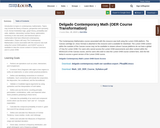This course is based on the text Math in Society, edited by David Lippman, Pierce College Ft Steilacoom, and on the text Using Excel, by Noreen Brown, Barbara Lave, Julie Romey, Mary Schatz, and Diane Shingledecker. The modules in this course have been adapted and edited by Gail Poitrast to fit the learning objectives of Math 502.
This course is a survey of contemporary mathematical topics, most non-algebraic, appropriate for a college-level quantitative literacy topics course for liberal arts majors. The text is designed so that most chapters are independent. Emphasis is placed on the applicability of the mathematics. The use of Excel is also explored, as it is a learning objective for Math 502.
The course’s content, assignments, and assessments for Math for Our World are aligned to the following topics:
Chapter 1: General Problem Solving
Problem Solving with Proportional Relationships and Geometry
Unit Conversion
Estimation, Precision and Accuracy
Chapter 2: Excel
Data Entering, Editing, and Formatting
Data Analysis, Statistical Functions & Formulas
Charts: Choosing & Formatting Appropriately
Chapter 3: Math of Finance
Simple and Compound Interest
Annuities and Loans
Chapter 4: Statistics: Collecting Data
Data Collection Basics
Sampling and Experimentation
Graphical Representation of Data
Chapter 5: Statistics: Describing Data
Measure of Central Tendency
Measures of Distribution
Chapter 6: Normal Distribution
The Normal Curve
Z-scores and Percentiles
Chapter 7: Probability
Computing the Probability of an Event
Applications With Probability



